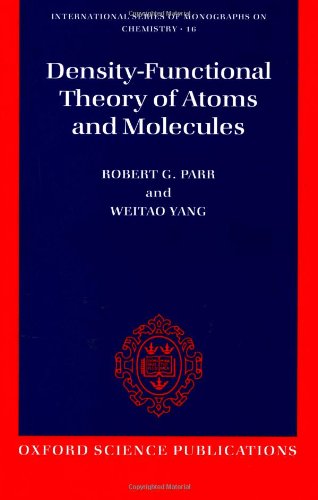Density functional theory of atoms and molecules pdf free
Par beckley eunice le mardi, mai 31 2016, 07:46 - Lien permanent
Density functional theory of atoms and molecules. Robert G. Parr, Yang Weitao

Density.functional.theory.of.atoms.and.molecules.pdf
ISBN: 0195042794,9780195042795 | 338 pages | 9 Mb

Density functional theory of atoms and molecules Robert G. Parr, Yang Weitao
Publisher: Oxford University Press, USA
One of the fundamental atomic and molecular processes that takes place in strong laser fields. Journal of Atomic and Molecular Physics Furthermore, a detailed DFT calculation on the molecular structure, molecular constants, and internal rotation parameters are reported and compared with the experimental values. DFT-D and DFT-D2 energy corrections consider all pairs of atoms while DFT-D3 also consider triplets of atoms to account for three-body effects. A molecular structure of 4, with the atom-numbering scheme. Isomers of the homoannular product were examined by DFT calculations. Cyclopentadienyl ring hydrogen atom and the Cp ring of neighboring molecule [H14∙∙∙Cgi (C-6–. In this Rapid Communication, we extend the time-dependent density-functional theory (TD-. The outcome of this result is that To corroborate the experimental findings and gain further insight into the exact nature of the contrast mechanisms, the team performed first-principles density functional theory calculations. The analysis is based on a synergistic combination of atomic-scale modeling tools, including first-principles density functional theory (DFT) calculations and classical molecular-dynamics (MD) and Monte Carlo (MC) simulations. The present status of Density Functional Theory (DFT), which has evolved as the main technique for the study of matter at the atomistic level, is described in this volume. Knowing the behavior of atoms and molecules provides a sure avenue for the design of new materials with specific features and properties in many areas of science and technology. EU funding has helped realise a scientific first; using a technique known as non-contact atomic force microscopy (AFM), scientists have successfully been able to differentiate the chemical bonds in individual molecules. Initially, molecular dynamics simulations (MD) are used to determine the relative coordinates of the tube and biomolecule atoms after exposure to the biomolecules in water. Molecular orbitals are then expanded in terms of atomic orbitals as linear combination of atomic orbitals (LCAO). Excited states can be computed within the Time-Dependent Density Functional Theory (for molecules), or within Many-Body Perturbation Theory (the GW approximation). This breakthrough will enable fundamental scientific insights into single-molecule switching and bond formation between atoms and molecules. STM constant-current image of a naphthalocyanine molecule, recorded with a CO-terminated tip. Recent experiments with diatomic molecules [3,4] of the target molecules.